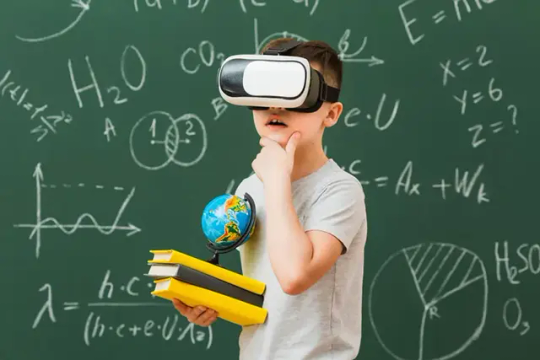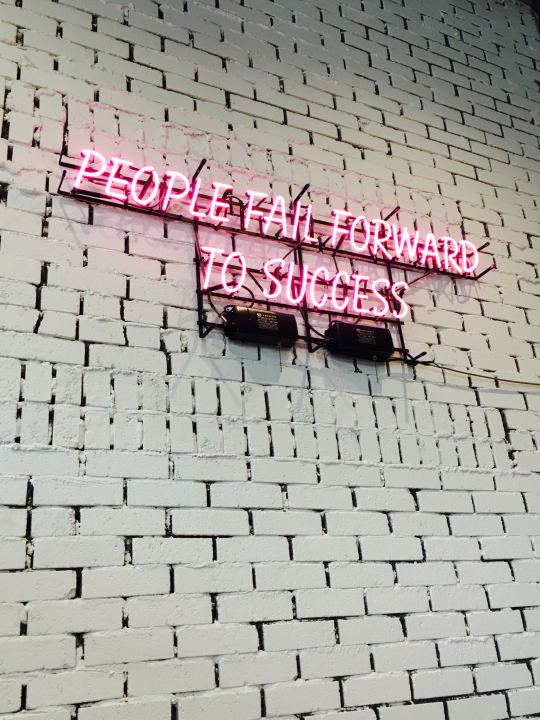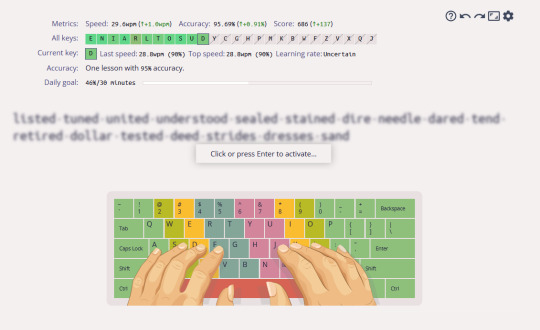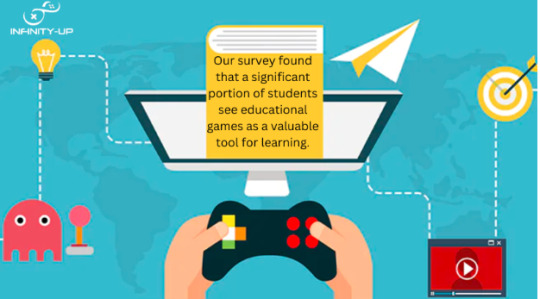#gamification of learning
Explore tagged Tumblr posts
Text
Engage Your Team: The Gamification Company's Employee Apps
Unlock the power of gamification apps for employee engagement with The Gamification Company. Our innovative solutions transform mundane tasks into exciting challenges, fostering a culture of collaboration and motivation. From interactive training modules to performance tracking tools, our apps inspire productivity and boost morale. With customizable features and real-time feedback, managers can effortlessly monitor progress and recognize achievements, driving continuous improvement. Empower your workforce to reach new heights and cultivate a vibrant work environment with The Gamification Company's cutting-edge solutions.
0 notes
Text
EduTech Marvels: Transformative Technologies in Education
If someone asks you to look for a restaurant for dinner, you will invariably search for it on the web. All of us are dependent on technology to find answers to common questions. The internet has taken the world by storm and is the most effective way to get answers to any question. In all fields, from travel to education, the impact of technology is felt everywhere. What seemed to be a distant…

View On WordPress
#Adaptive Learning Technologies#Artificial Intelligence#Blockchain Technology#Cloud-Based Learning#EduTech Marvels#Gamification Of Learning#Robotics#Technologies In Education#Virtual And Augmented Reality
0 notes
Text

02.09.2024
Quests for Today:
Wake up early (+15)✅️
PAD day at work (+35)
Walk home (+10)✅️
Rethink day (+5)✅️
Go on a run (+15) ✅️
Do an R practical (+10) ✅️
Read through Bioinformatics notes from friend (+15)
Do Core Workout (+10) ✅️
Make Apple Strudel Mix (+5)
Crochet a square for cardigan (+5) ✅️
CURRENT POINTS: 70
WIN CONDITION: 60
WIN
~~~~~~~~~~~~~~~~~~~~~~~~~~~~~~~~~~~~~~~~~~~
I got a letter from my excellent friend today, so that's absolutely made my day.
Yesterday we went on a long walk up a local hill, which tired us out and I ended up having a nap. The transition from August to September has been especially sharp here, with the last day of August being glorious sunshine, and then the first two days of September being full of mist and drizzle, which made the walk up the hill rather bracing. To commemorate the last days of summer, I have attached an image from back when it was sunny here.
#diary blog#studyblr#chaotic academia#realistic studyblr#university student#motivation#studying#mycelium management#uni life#stemblr#stem academia#study motivation#study blog#stem student#To do list#Eden's lists#WIN!#we won today#gamification#programming#productivity#time management#learning#coding
8 notes
·
View notes
Text

Going through some notes today for an upcoming conference session called Failure: It's a Feature, Not a Bug. Years ago I was at another conference as several of us were talking about gamification and included content about normalizing and reframing failure and such. One Dutch attendee I spoke with later laughed at how Americans had an issue with failure. He said something to the effect of "we just expect it."
Another friend in Spain frequently uses the acronym FAIL as First Attempt In Learning. In my notes I had been exploring other ways to use the letters to build positive views of failure, such as Forward Isn't Always Linear. I had, of course, come up with some negative ones too: F#@K, I'm a Loser.
I'll stick with the positive ones. And yes, the shortest distance isn't always a straight line. Especially when learning new things or making changes. Sometimes you have to step back or take a detour or try a different approach. These may not look like progress, but often are.
Photo by Ian Kim on Unsplash
6 notes
·
View notes
Text

Genuinely my longest habit since Friday art group in my school days.
#currently i am play-learning swedish#and before that french and russian (and some arabic japanese and spanish. and whatever else seemed interesting)#(i might just start looking at finnish because the language is nice)#personal log#duolingo#the gamification is annoying but not enough to stop
6 notes
·
View notes
Text
Revolutionizing Training: The Power of Gamification in Learning and Development
In today’s fast-paced, digitally-driven world, traditional training methods are rapidly giving way to more engaging and interactive approaches. One of the most impactful trends reshaping the corporate training landscape is gamification in learning and development. By integrating game-like elements into educational content, organizations are finding innovative ways to boost employee engagement, enhance knowledge retention, and improve overall learning outcomes. At SB Animation, we help companies harness the power of gamification to transform training into a more dynamic and rewarding experience.
What is Gamification in Learning and Development?
Gamification involves applying game mechanics—such as points, levels, badges, challenges, and leaderboards—to non-game environments. In the context of learning and development, these mechanics are embedded into training programs to make learning more engaging and motivating. Whether through interactive modules, scenario-based simulations, or animated assessments, gamification taps into the natural human desire for achievement, competition, and progress.
Boosting Engagement and Motivation
One of the biggest challenges in corporate training is keeping learners engaged. Traditional methods such as lectures, static slide decks, or lengthy manuals often fail to capture attention, leading to poor retention and minimal impact. Gamification in learning and development changes this by making the process more enjoyable and interactive. When employees are presented with challenges, rewards, and instant feedback, they become more invested in the learning journey.

At SB Animation, we incorporate compelling narratives, character-driven scenarios, and animated game elements that draw learners in and maintain their interest. This active participation leads to a deeper understanding of the content and fosters a more positive attitude toward training.
Encouraging Continuous Learning
Gamification doesn’t just make learning fun—it also encourages consistency and progression. Learners are more likely to return to training modules when they can see measurable progress, unlock achievements, or compete on leaderboards. This kind of positive reinforcement supports continuous learning and helps organizations build a culture of development.
Through customized gamified solutions, SB Animation enables companies to create learning paths that evolve with employee performance. As users complete each level or challenge, the system adapts to provide more advanced content, helping individuals grow at their own pace while still meeting organizational goals.
Measuring Performance and ROI
Another significant benefit of gamification in learning and development is the ability to track performance in real time. Gamified systems generate data on learner progress, completion rates, response accuracy, and engagement levels. This data allows organizations to assess the effectiveness of their training programs and make informed decisions for future development.

At SB Animation, we build gamified training tools with integrated analytics to provide valuable insights for HR and L\&D teams. These insights help in refining the training strategy, identifying skill gaps, and ensuring that learning initiatives are aligned with business objectives.
Transform Training with SB Animation
By embracing gamification in learning and development, companies can transform the way employees learn, grow, and contribute. At SB Animation, we bring together creativity, animation, and strategic design to deliver immersive learning experiences that drive real results. Let us help you turn training into a powerful tool for engagement, performance, and long-term success.
0 notes
Text
Transforming Education: The Role of AR/VR and Gamification in E-Learning Platforms
Benefits of using AR/VR integration
In the modern age of digital transformation, traditional classroom learning is evolving rapidly. One of the most exciting advancements is the integration of AR/VR (Augmented Reality and Virtual Reality) into e-learning online platforms. These technologies, when combined with gamification, are opening new doors to immersive, engaging, and effective learning experiences.
What is AR/VR Integration?
AR/VR integration refers to the use of augmented and virtual reality technologies within educational content. AR enhances the real-world environment by overlaying digital elements, while VR provides a fully immersive digital experience that can simulate real-life situations.
For instance, instead of reading about ancient history, learners can walk through a virtual ancient city. Instead of watching a video on human anatomy, students can interact with a 3D model of the human body using AR.
Why Use AR/VR in E-Learning?
There are many benefits of using AR/VR integration in e-learning, including:
Increased Engagement: Learners are more likely to stay focused and interested.
Hands-On Experience: Learners can practice skills in a virtual environment before applying them in the real world.
Enhanced Memory Retention: Interactive visuals and experiences are easier to remember than text or video alone.
Learning by Doing: Students can perform tasks and make decisions in realistic scenarios.
AR/VR with Gamification: A Perfect Match
Combining AR/VR with gamification takes learning to a whole new level. Gamification applies game design elements—like points, rewards, levels, and progress tracking—to educational content. When learners interact with virtual environments and are rewarded for completing tasks or solving challenges, their motivation increases significantly.
Imagine a sales training module where employees use VR to interact with virtual customers, or a geography lesson where students earn badges by exploring different countries in AR. These engaging methods turn learning into an experience, not a chore.
AR/VR Games: Education Meets Entertainment
AR/VR games are making learning fun and effective. These games are especially useful in teaching complex topics, developing soft skills, and training in high-risk professions. For example, a VR game can simulate emergency response scenarios for firefighters, or an AR game can teach children how to solve math problems by interacting with objects in their environment.
The Future of Learning
As technology continues to evolve, e-learning online platforms will become more interactive, intelligent, and learner-focused. AR/VR integration and gamification are no longer futuristic ideas—they are tools that are already shaping the way we learn today.
Organizations and educational institutions that embrace these technologies are not just keeping up with trends—they’re setting new standards in education.
#lms for coaches#gamified lms#lms with gamification#lms game#lms gamification#enterprise training platform#interact lms#gamification lms#AI Coach LMS#gamification in LMS#lms virtual classroom#lms for fitness#lms roi#ar/vr integration#Benifits of using ar/vr integration#AR/VR with gamification#AR/VR games#e-learning online platform
0 notes
Text
Creating Transformative Experiences with cityHUNT

group of people completing a cityHUNT experience When I started cityHUNT over 20 years ago, I was obsessed with a question: How do we help people reconnect—with themselves, with each other, and with the world around them—through something as simple as play?
Inspired by Mihaly Csikszentmihalyi’s work on flow theory, I wanted to bring the magic of immersive, joyful moments into corporate environments that too often forget the value of laughter and creativity.
My co-founder and I constantly tweaked the game mechanics around the principles of flow, trying to create experiences that would be meaningful and transformative.
What began as a simple idea has evolved into something that drives everything else I do—from nonprofit work to my upcoming book.
Table of Contents
Our Mission: Positively Impacting Companies
The Three Pillars: Playfulness, Connection, and FlowPlayfulness
Connection
Flow
Designing for All: Diversity as a Superpower
What Makes cityHUNT Different
The Evolution of cityHUNT
Lessons from the Early Days
Impact Beyond Participants
Conclusion
Our Mission: Positively Impacting Companies At its heart, cityHUNT is about positively impacting companies.
We aim to help organizations through our unique team-building experiences. The more people we can reach and introduce to cityHUNT, the further our mission spreads.
This isn’t just about business growth; it’s about creating more abundance that, in turn, helps us fund other events and projects aimed at making a positive difference.
The Three Pillars: Playfulness, Connection, and Flow
Playfulness As humans, we naturally play as children, just as animals do.
But we often forget how to play as we get older, even though it’s one of the best paths to joy and bliss.
At cityHUNT, we create space for adults to reconnect with that childlike playfulness.
Play doesn’t need an end result; the play itself is the point. This contrasts with the productivity-focused mindset many of us develop.
Ironically, when we make space for play, our ability to produce actually blossoms rather than narrows.
Connection Our second pillar is about fostering meaningful connections.
I’ve come to understand connection as a three-layered concept:
Connection with oneself
Connection with other people
Connection with nature and the world around us
These connections work like a pyramid. You need to build that inner work first so that you can truly connect with others without needing anything from them.
When you’re fulfilled within yourself, you can connect with others from a place of openness rather than manipulation or coercion.
At cityHUNT, we create opportunities for all these levels of connection, but especially focus on human-to-human interaction.
While you can have fun by yourself, playfulness is typically a shared experience that strengthens bonds between people.
Flow Flow occurs when people engage in activities that are challenging enough to be interesting but not so difficult that they become frustrating.
We design tasks to hit this sweet spot for different personality types.
Mihaly Csikszentmihalyi’s research on flow states was foundational to how we developed cityHUNT.
We wanted to create experiences where time seems to disappear and people become fully present in the moment. That’s when true transformation can happen.
I’m grateful for thinkers like Catherine Price, who has spoken deeply about the science of play, and Jamie Wheal from the Flow Genome Project, who’s expanded how we understand peak experience.
Their work continues to influence how we design our experiences.
Designing for All: Diversity as a Superpower cityHUNT events are crafted to celebrate differences. Some people thrive in social challenges, others prefer mental puzzles.
We ask clients about their team dynamics upfront and design experiences that allow everyone—from the CEO to the quietest team member—to shine.
For extroverts, we include challenges like singing a song to a stranger or doing a TikTok dance.
For introverts who might enjoy solving puzzles, we include more cerebral challenges. This ensures everyone has their moment to shine.
I come from a theater background, so I think of our events almost like plays, where each person gets to be the star in their own way.
We create moments where different strengths are valued—a maintenance person might know something crucial that a CEO doesn’t, highlighting how everyone brings unique value.
Our teams are specifically designed to be four to six people.
It’s the magic number for team building—intimate enough to build real connections and big enough to harness diverse talents.
With fewer than four people, you lose the diversity of thought and skills needed to solve challenges effectively.
With more than six, some participants start to disengage or form smaller subgroups.
What Makes cityHUNT Different Our approach isn’t about high-tech gamification for its own sake. In fact, only one person per team uses a device.
The rest is face-to-face, voice-to-voice.
Our job is to remove friction and invite people to be present. If we’ve done our job, they forget it’s a team-building exercise—they’re just laughing, solving, and seeing each other.
One thing we’ve mastered over 25 years is how to create team-building experiences for very large groups.
Once you get beyond 30–50 people, most team-building activities become unwieldy. But we’ve developed the expertise to run events for hundreds or even thousands of participants.
We’ve perfected the art of routing teams through geographical areas that are neither too small (where teams are on top of each other) nor too large (where it becomes physically exhausting).
We create an arc where everyone starts together as a large group, then breaks into small teams for intimate bonding experiences, and finally reunites to celebrate as a whole.
The Evolution of cityHUNT The company has evolved significantly over the years.
When we started in 2000, we could only provide 10 clues because we only had 10 Polaroid pictures!
As technology advanced to digital cameras and eventually smartphones, we were able to scale and enhance the experience.
We were paper-and-pen for longer than we’ve been digital, which is amazing to think about.
Technology has helped us scale while staying true to our mission.
Having immediate feedback is a crucial part of flow, and as technology evolved from Polaroid cameras to digital cameras to smartphones, we’ve been able to provide better, more immediate feedback while still keeping the focus on human interaction.
What’s interesting is that we’ve used technology to connect people instead of allowing it to separate them.
We’ve harnessed technology to scale our experiences to thousands of participants without losing the personal touch.
Lessons from the Early Days We didn’t get it right from day one. Early on, teams got lost, no one had cell phones, and we overcomplicated everything.
But the intention was always there: to make something beautiful happen when people come together to play.
Looking back, we made many mistakes.
We’d overthink everything—creating multiple variations of each clue (easy, medium, hard), adding complexities that didn’t enhance the user experience but just seemed “cool” to us as designers.
We had to learn through trial and error what actually worked.
Over time, I’ve spent considerable effort studying positive psychology, gamification, and mindfulness to refine our approach.
I started with gamification, then dove into positive psychology, and finally added mindfulness—realizing that participants could have moments of personal realization and self-reflection during our games, something I hadn’t initially thought possible.
Impact Beyond Participants Our mission is to positively impact over a million people, and the math works out.
First, the game itself requires participants to interact with strangers��helping someone, opening a door, singing a song.
Then, participants share their positive experiences with family and friends. And those strangers who were impacted during the game also share their experiences.
It’s like ripples in water or the Big Bang—an initial positive interaction spreads outward exponentially. With technology and social sharing, the impact multiplies quickly.
We even have YouTube videos with over 100,000 views. When you think about it this way, reaching a million people isn’t that difficult in our connected world.
Conclusion Everything I do—cityHUNT, my future book, the nonprofit work—rests on this foundation: abundance through connection.
cityHUNT is how we fund it all, but it’s also how we live our mission. We help people help themselves by creating spaces where joy and collaboration are possible.
In 2019, my perspective shifted significantly.
Before that, I spent most of my time working on external things and building material success.
But starting in 2019, I began focusing more on inner work and developing a new understanding of happiness and fulfillment.
I realized that all happiness comes from within. The external stuff is great, but when I lean into it too much, it causes suffering.
I also realized that no one can actually help me—they can only help me help myself. Similarly, I can’t directly help others—I can only help people help themselves.
This three-layered connection approach has transformed how I live and how I approach my business.
The inner work serves as the foundation, enabling me to better support my community and the larger world through cityHUNT and all my other endeavors.
Learn more about this philosophy and upcoming projects at benjaminpeacehoffman.com.
#cityHUNT#Team Building Experiences#Corporate Team Building#Playful Leadership#Flow Theory#Mihaly Csikszentmihalyi#Connection and Collaboration#Positive Psychology#Mindfulness in Business#Gamification#Diversity and Inclusion#Employee Engagement#Interactive Team Events#Leadership Development#Group Dynamics#Experiential Learning#Large Group Activities#Benjamin Peace Hoffman#Tom Dillon CFA#Transformational Experiences
1 note
·
View note
Text
youtube
0 notes
Text

idk man, I prefer the simulations
#clozemaster#it's pretty cool i guess#i am a duolingo fan 'cause of my adhd brain idk#gamification here we gooo#am i actually learning anything? feck if i know#text post#random
0 notes
Text
Transforming a Global Assurance Firm: A Strategic Overhaul
In an era where adaptability is key, a leading global assurance firm recognized the need for a comprehensive transformation to stay ahead. Partnering with Unbox Experience, they embarked on a journey to redefine their strategic approach, aiming to enhance operational efficiency and client satisfaction. This case study delves into the challenges faced, the innovative solutions implemented, and the remarkable outcomes achieved.
Explore the full story here
https://unboxexperience.com/case-studies/strategic-transformation/global-assurance-firm
0 notes
Text
How EdTech Startups Are Revolutionizing Secondary Education Delivery?

Education is the basic right of an individual. Secondary education imparts a structural foundation to a person’s primary foundation of knowledge. The emergence of edtech startups has led to a major shift in the way educational institutions function. Due to the adoption of technologies in educational institutions, the intensity of the concepts explained to students has deepened, unlike traditional schooling, which has resulted in a massive surge in the number of students getting good grades & becoming better at facing the world.
The Startup Surge in Secondary Education
EdTech startups have seen explosive growth in the past decade, with U.S.-based education technology investments reaching $8.3 billion in 2022 alone, according to HolonIQ. These startups are tapping into a market hungry for scalable, tech-enabled solutions to age-old educational challenges. From AI-powered tutoring systems to gamified platforms, secondary education is being redesigned to meet the demands of a digitally native generation.
These emerging companies are not merely supplementing traditional instruction. They are transforming how secondary education is delivered, assessed, and experienced. The key lies in their agility. Unlike public institutions, startups can quickly pilot, pivot, and iterate their solutions based on real-time feedback from students and educators.
Personalized Learning at Scale

[Source - Khan Academy]
One of the most profound impacts of EdTech startups is the ability to personalize learning at scale. Platforms like Khan Academy, Sora Schools, and Classcraft are offering tailored content that adapts to each student's pace, learning style, and interests. This marks a significant departure from the one-size-fits-all model that has long dominated secondary education.
With the help of data analytics and machine learning algorithms, these platforms identify knowledge gaps and adjust content in real time. This not only boosts student engagement but also improves retention and academic outcomes. For business leaders, the implication is clear: tech-driven customization is not a luxury, but a new standard.
Gamification and Engagement
Engagement remains a central challenge in secondary education. According to a Gallup poll, only 47% of high school students reported feeling engaged in their classes. EdTech startups are addressing this through gamified experiences that make learning interactive and enjoyable.
Apps like Duolingo and Prodigy Math Game employ points, badges, and leaderboards to motivate students. These elements, drawn from behavioral science and gaming psychology, create a compelling learning environment that fosters both curiosity and competition.
For school districts and private investors alike, this engagement-driven approach signals a more sustainable model of educational success.
Accessibility and Equity
Another area where EdTech startups are making a critical impact is in promoting equity in secondary education. Geography and socioeconomic background have long determined access to quality education. With digital platforms, students in underserved communities can now access the same quality of instruction as those in affluent districts.
Companies like Outschool and Prenda offer live and asynchronous classes on a wide range of subjects, helping to level the playing field. While challenges like device availability and internet access still persist, the cost-effectiveness of these platforms makes them a viable option for both public and private sector partnerships.
Real-World Skills and Career Readiness

A growing number of EdTech startups are also aligning their content with real-world skills. Platforms like Nepris and Coursera for high school offer courses that introduce students to coding, entrepreneurship, design thinking, and financial literacy.
Secondary education is no longer just about passing exams; it’s about preparing students for life beyond the classroom. As the talent market becomes more skills-driven, these startups are playing a key role in shaping a future-ready workforce. For corporate leaders, this represents an opportunity to collaborate with educational institutions to ensure students are equipped with industry-relevant competencies.
The Role of AI and Data
Artificial Intelligence is becoming the engine behind many innovations in secondary education. From grading essays to identifying behavioral patterns, AI tools are helping teachers focus more on instruction and mentorship rather than administrative overhead.
Startups such as Squirrel AI and Querium use AI to provide real-time insights into student performance. These insights allow for timely interventions, reducing dropout rates and boosting performance. This data-centric approach aligns well with how business leaders already make decisions, measured, analytical, and results-driven.
Challenges Ahead
Despite the promise, integrating EdTech into secondary education isn’t without its hurdles. Issues around student data privacy, screen time management, and resistance from traditional educational systems remain significant. Moreover, not all EdTech solutions are created equal. The market is flooded with apps that promise much but deliver little.
Business stakeholders, therefore, have a critical role to play not just as investors but as strategic partners who can demand accountability, encourage evidence-based practices, and drive quality standards in this rapidly evolving sector.
Looking Forward
The intersection of innovation and education has never been more exciting. As EdTech startups continue to disrupt and redefine secondary education, there is a growing need for alignment between business, policy, and pedagogy. For decision-makers in both public and private sectors, now is the time to engage, invest, and influence the direction of this transformation.
Secondary education is not just evolving; it’s being rebuilt from the ground up, with technology as its cornerstone and innovation as its compass. As this momentum builds, the next generation of learners won’t just be consumers of information; they’ll be architects of knowledge, ready to thrive in an ever-changing world.
Public-Private Collaboration: The Way Forward

To fully realize the transformative potential of EdTech in secondary education, public-private collaboration must take center stage. Policymakers can create innovation-friendly regulatory environments, while private companies provide the capital and expertise necessary for scaling up effective solutions. Initiatives like the Education Innovation and Research Program, backed by federal grants, offer a glimpse into how these collaborations can be operationalized for mutual benefit.
Corporate partnerships can also create mentorship pipelines and internship programs that bridge the gap between academic content and real-world application. Tech companies like Google and Microsoft have already launched high school-focused certification programs and digital literacy curricula. These initiatives not only enhance learning outcomes but also give students a competitive edge in the job market.
EdTech's Role in Teacher Empowerment
While much of the attention has been on student-facing innovations, EdTech is also empowering educators. Tools that automate administrative tasks, like grading and attendance, are freeing up teachers’ time for instruction and student engagement. Professional development platforms such as TeachFX and BetterLesson provide real-time coaching and instructional feedback, helping teachers refine their methods.
By improving the support system for teachers, startups are making secondary education more resilient and adaptive. A teacher armed with data, insights, and tools becomes not just a deliverer of content but a facilitator of critical thinking and innovation.
Measuring Impact and Ensuring Accountability
As investments pour into the EdTech space, accountability must remain front and center. The true measure of success in secondary education should not be app downloads or flashy dashboards, but tangible learning outcomes, improved graduation rates, and student satisfaction.
Emerging metrics like Student Growth Percentiles (SGPs) and personalized learning analytics are helping stakeholders assess the efficacy of digital learning tools. Independent third-party evaluations and public reporting can ensure that innovation remains accountable and equitable.
Conclusion:
The revolution underway in secondary education is not a fleeting trend; it is a structural shift with long-term implications. For EdTech startups, educators, investors, and policymakers, the goal must be collective: to prepare students not just for exams, but for the complexities of the modern world. With strategic alignment, continuous innovation, and a commitment to quality, secondary education delivery can become a model of excellence in the digital age. This is not just an opportunity for growth, it is a responsibility to shape the future of learning.
Uncover the latest trends and insights with our articles on Visionary Vogues
0 notes
Text
The Metaverse is transforming education by enabling immersive, interactive, and engaging learning experiences. Simulanis, a leader in AR, VR, MR, and Metaverse solutions, is at the forefront of this revolution, developing cutting-edge immersive learning technologies for various industries.
#Metaverse education#VR learning solutions#Simulanis Metaverse#Virtual classrooms#Immersive learning#VR training for students#Augmented reality education#AI in education#Gamification in learning#Industrial training in VR#Virtual reality for schools#Metaverse training simulations#Experiential learning technology#Digital twins in education#Simulanis VR training#AI-powered education#Remote learning with VR#Blockchain in education#Future of e-learning#VR medical training#Augmented reality classrooms#Virtual skills development#Metaverse for corporate training#EdTech Metaverse solutions#Interactive learning environments#VR language learning#Simulanis AR VR solutions#Metaverse-based e-learning#Haptic feedback in education#Next-gen education technology
0 notes
Text
youtube
0 notes
Text

This silly little website is so cool
#Gamification of learning normally doesn't do it for me (mb it's alr overall but I'm thinking about duolingo rn&it's bad)#But this is awesome#Keybr.com btw
0 notes
Text
Redefining Learning: The Game-Changing Approach of Learning Through Play

Games aren’t just for fun—they’re powerful educational tools! This article explores how game-based learning enhances engagement, boosts retention, and sharpens critical thinking. Let's look at how different game mechanics can be applied to various educational contexts and the benefits of incorporating play into traditional learning environments. Read the full article here: https://lnkd.in/d-HA2S84 Let's create engaging learning experiences together. Contact INFINITY-UP to get started!
#gamification#education#elearning#learning#edtech#artificial intelligence#traning#engagement#fintech#video games#gamedesign#marketing#gamedevelopers#browsergames#gamechanging#sales#Infinityup
0 notes